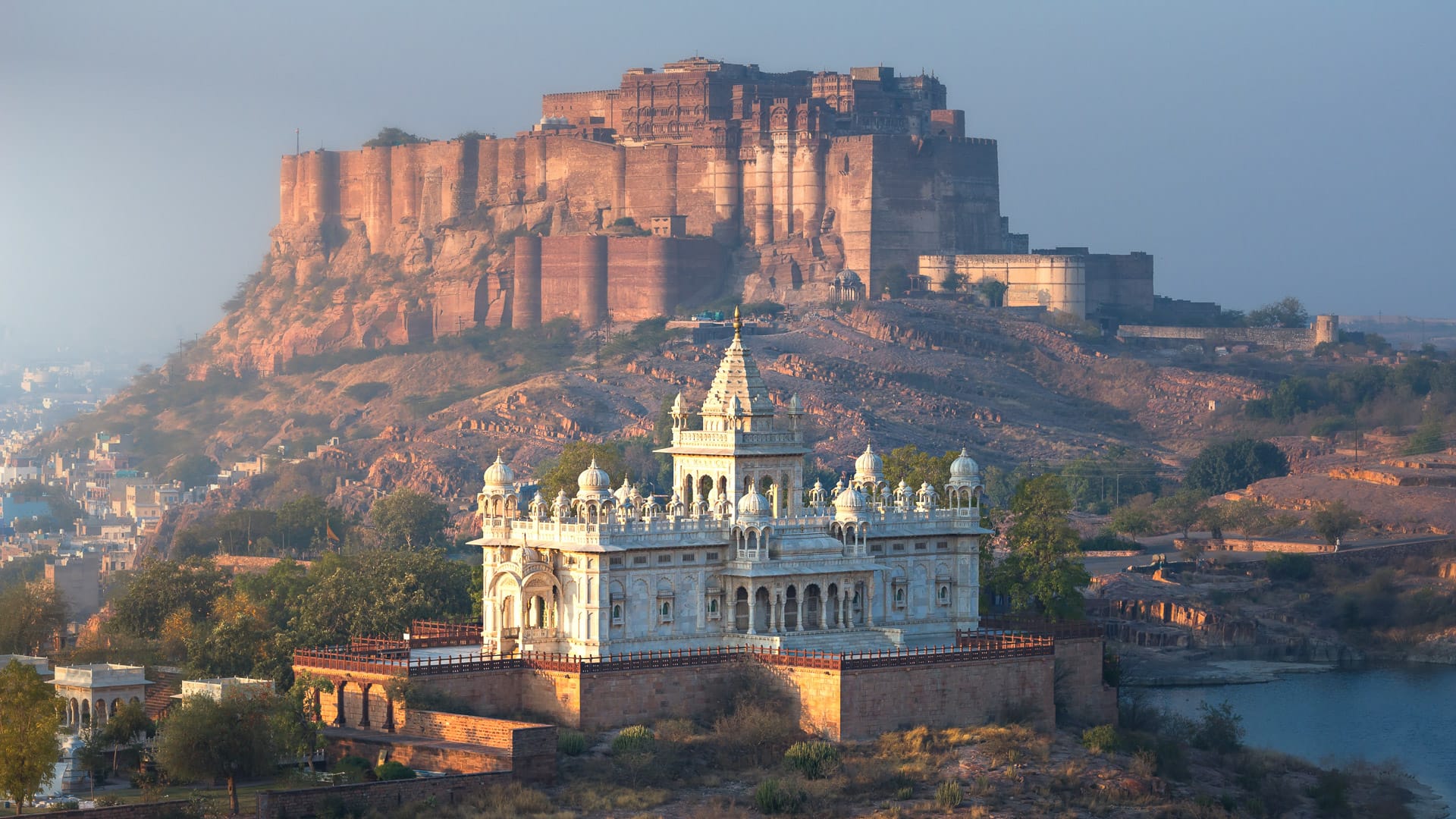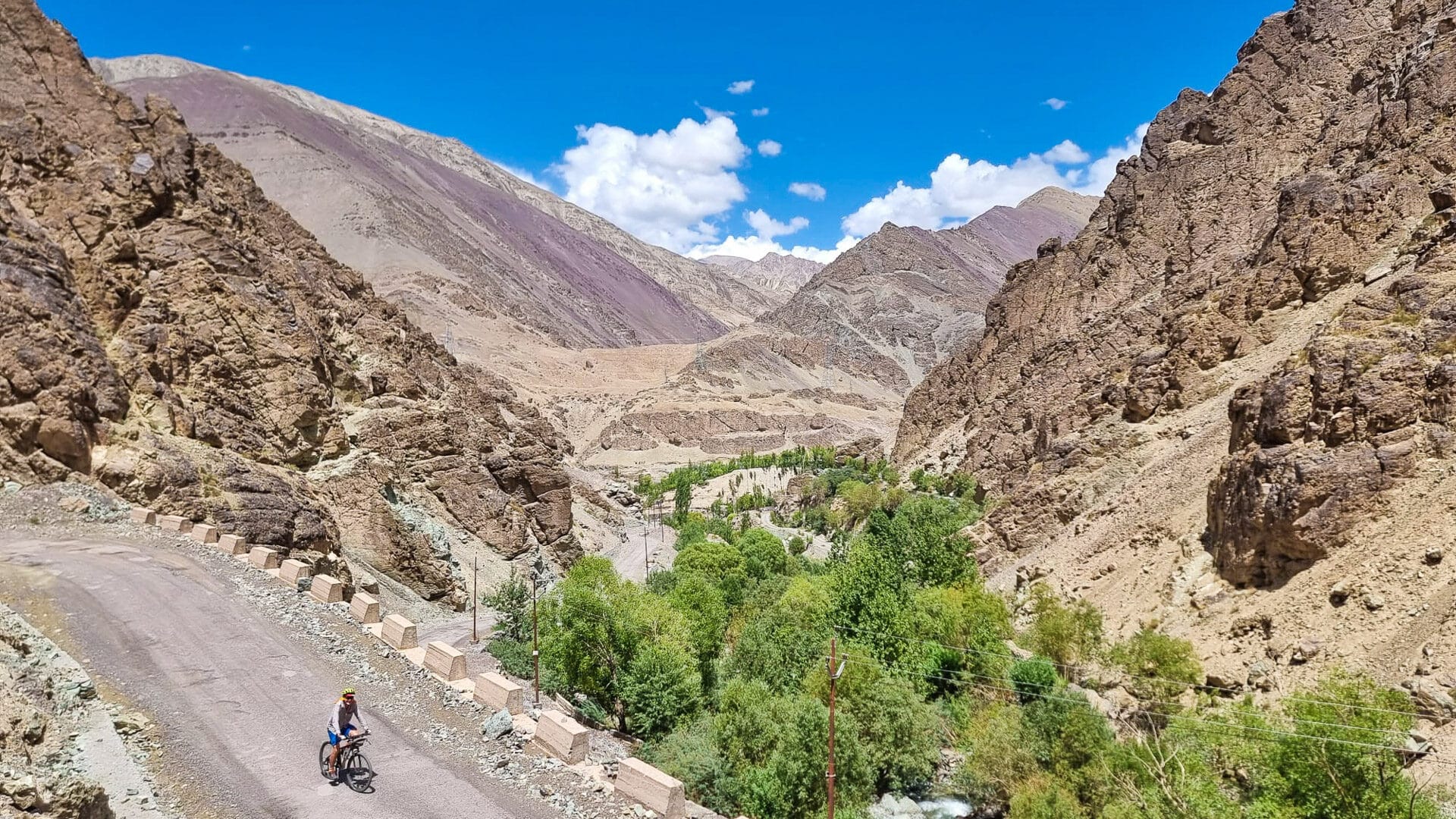If you are considering a cycling trip in India, you’re in the right place. From lush rural landscapes and palm‑lined beaches to chaotic, culturally-rich cities and serene Himalayan climbs, cycling in India is an adventure of a lifetime.
This article draws on our own first‑hand holidays in India in 2009 and 2012, as well as the interviews we’ve run with operators about their cycling tours in India in the intervening years. Here we bring you a carefully curated list of practical tips for planning your trip.
Whether you’re heading to the beaches of Goa or the mountains of Himachal Pradesh, read on and plan your next cycling adventure.
1. Choose your region carefully
India is huge and varied, so your experience will be completely different depending on where you go. If you’re after coastal cycling, the stretch from Mumbai to Kerala is a tropical paradise. The terrain is rolling rather than mountainous, with quiet roads weaving through palm plantations, traditional fishing villages and vast beaches. You’ll find lots of places to stop for chai, local snacks and warm hospitality.
In contrast, if you want high-altitude adventure, try the Himalayan foothills near Manali or Leh. Here, the roads are remote, the climbs are challenging, and the scenery is jaw‑dropping. Be aware that these areas are very seasonal – some roads are only open in summer months as snow and road closures can make things difficult at other times.
Our guide to cycling in India has a detailed section on some of the best parts of India for cyclists.

Map of India
2. Expect contrasts in traffic and road conditions
Globally, Indians top the list of those who ride a bike at least once a week (source).
But what is it actually like to cycle there?
Roads in India range from glassy smooth highways to broken tracks and dusty trails. Expect the unexpected – potholes, goats, slow‑moving lorries and auto‑rickshaws may all share your space. In cities like Mumbai or Delhi, traffic can be intense, loud and chaotic, with little regard for Western‑style road etiquette.
Once outside the cities, you’ll find some beautifully quiet rural cycling routes, especially on the coast or in the hills. Our advice: get early starts. Roads are quieter and temperatures cooler before the day heats up, and you’ll avoid the stress of riding during the busiest hours. It’s often possible to cover 60 to 80 kilometres by midday, leaving time for a long lunch and siesta.
3. Food and hydration: be curious but cautious
Indian food is famous for its spices, colour and variety. One of the great joys of cycling in India is the abundance of roadside food stalls, sweet shops and tea vendors. You’ll find everything from spicy samosas and idli (rice cakes) with chutney to fresh sugarcane juice and lassi (a refreshing mango drink). Chai stops are social hubs and great for short breaks.
That said, not all food is cyclist‑friendly, and you don’t want your cycling tour to be overshadowed by illness. It pays to go slow when introducing your stomach to local cuisine, and to always drink filtered or bottled water. Most travellers experience some stomach upset, so come prepared with rehydration salts and basic first aid. It’s wise to carry a water purifier or Steripen, especially if you’re cycling rural India where bottled water might not always be available.
We’ve got more detail on what to eat on a cycling trip in India in our guide to cycling India.
4. Pack smart for heat, dust and rain
India’s climate is mostly hot and humid, especially on the coast or in the plains. Temperatures in many regions regularly hit over 30°C during the day. Lightweight, breathable clothing is essential. Opt for long sleeves and full‑length trousers in rural areas where modesty is appreciated. A buff or scarf is great for filtering dust and sun, especially when passing trucks or roadworks.
If you’re travelling during or near the monsoon season, bring a waterproof jacket and keep valuables in dry bags. Rain can arrive quickly and heavily. Or plan your trip just after the monsoon when the landscape is lush and green.

Gentle cycling through Rajasthan (photo credit: Pedal Nation)
5. Embrace the social nature of cycling in India
In India, people are curious and friendly, especially when they see you on a bicycle. Expect waves, questions, photo requests and possibly even invitations to tea or dinner from strangers. For many Indian villagers, a fully loaded touring bike is a novelty, and you may find yourself the subject of local interest wherever you go.
This may not always be what you want – for example, you may find yourself surrounded by a gaggle of onlookers seeking your attention and asking questions when all you want to do is fix your flat and move on.
While it can feel intense at times, conversations with local families, kids cycling to school, or chai stall owners keen to hear your story can also be one of the most memorable parts of a trip.
Keep your interactions friendly and respectful. Learning a few words of Hindi or the regional language can go a long way in building connections.
6. Be flexible and go with the flow
India runs on its own rhythm. Expect that things may not always go to plan – ferries may be delayed, roads might suddenly close, and your guesthouse booking might have disappeared. But if you approach your cycling holiday with patience and humour, you’ll usually find a solution. Often, the most memorable experiences came from unexpected changes in plan.
Touring India by bike is not about precision timing. It’s about exploration and openness. You’ll find joy in riding through tiny villages, stumbling upon a festival, or being invited to camp on someone’s land by the beach. Build slack into your schedule and don’t try to cram too much in. Less is more.
7. Understand the best times to go
Weather patterns vary hugely by region. Winter (November to February) is the most popular time to cycle India’s southern and coastal regions. You’ll get sunny days and manageable heat. Avoid May and June in the plains, where temperatures can exceed 40°C. July to September is monsoon season, with heavy rainfall especially on the western coast and in Kerala.
If you’re planning a Himalayan cycling holiday, aim for May to September, as many roads are closed in winter due to snow. Ladakh and Himachal Pradesh all have short riding seasons, but the rewards are immense – desert mountain roads, peaceful Buddhist monasteries, and epic climbs above 4,000 metres.
This section of our article on cycling in India contains more info on when to go where.

Khardung La, Ladakh (photo credit: Pedal Nation)
8. Prepare your bike and spares
You’ll want a reliable touring bike with wide tyres and a solid rack system. Road conditions can be tough, and good‑quality bike shops are rare outside major cities. Bring all essential spares: tubes, tyres, brake pads, tools and a chain tool. A hybrid or gravel bike is ideal, as it can handle broken tarmac and off‑road sections without issue.
Don’t count on finding specific parts on route. If you bring your own bike and it has specialist components, you are highly unlikely to find parts, so come prepared.
9. Accommodation and camping
Accommodation options range from budget guesthouses to boutique homestays, jungle retreats and larger hotels. Booking ahead is possible in most towns, but spontaneous stops are also easy thanks to the density of India’s population and frequent villages.
Be beware that wild camping is strictly prohibited in protected areas. It is possible to camp in some rural places, but seek permission and camp discreetly. In our experience, villagers are generous and may invite you in for dinner or to stay on their land. In some states, such as Goa, you may also find eco‑resorts or beach huts that welcome cyclists.
For suggestions of cycling friendly accommodation in Rajasthan, Ladakh and Kerala, read this section of our article on cycling in India.
10. Be aware of cultural expectations
India is a deeply religious and traditional country. Dress modestly, particularly in rural areas. For women, covering shoulders and knees is essential to avoid unwanted attention. Public displays of affection are rare and best avoided.
Remove your shoes before entering someone’s home or a temple. Be polite when taking photographs – especially of people. Always ask first. Respect local customs and be prepared for different norms around time, personal space and queuing.
A sense of humour and humility will take you far.
We’ve got more tips for cycling safety in India in our overview to cycling in India.

Jodhpur at sunset with a view of the Mehrangarh Fort, a UNESCO World Heritage Site
11. Stay safe and informed
India is generally welcoming to foreign travellers, but it’s wise to stay updated on local conditions. Monitor government travel advisories and keep your valuables secure. If you’re travelling alone, particularly as a woman, choose well‑lit accommodation and avoid riding in the dark. Many solo female cyclists have had positive experiences, but extra caution is advised.
Use offline navigation apps like Maps.me or Komoot, since mobile data coverage is inconsistent in rural areas. Also download Indian train and bus apps in case you need to skip a section. Trains can carry bicycles, but you’ll need to book in advance.
12. Consider joining a guided tour
If it’s your first trip to India or you’re short on time, consider a guided cycling tour of India. Tour operators handle logistics, accommodation, meals and support vehicles – allowing you to focus on the ride. It’s a great way to get an introduction to India without the stress of planning every detail.
You can choose from group trips, private tours or even hire a guide to accompany your independent ride. There are tours for every level – from relaxed coastal rides to high‑altitude challenges. Operators can tailor their experiences to cyclists’ needs and use routes well‑tested over years of travel.
Check out our interview with Pedal Nation, who have run tours in India since 2014 (and who have a special offer for our readers – click through to get it).

Kerala (photo credit: Pedal Nation)
What’s next?
Planning to cycle in Asia and looking for more resources? Check out these pages:
- Cycling in India: routes, tours and what to expect
- Guide to the best cycling tours in Asia
- Guide to cycling in Singapore
- Tips for a cycling tour in Vietnam
- Cycling Vietnam to Cambodia
- Guide to cycling in Borneo
- Guide to cycling Japan
Let us know in the comments – what part of India would you most like to explore by bike?
Please support Epic Road Rides
A huge amount of time and effort goes into the article you’ve just read, all with the aim of helping you!
If you found what you’ve read useful, I’d really appreciate it if you dropped something in the tip jar here.
It’s a way you can say thank you and help us carry on creating top quality content with no annoying ads and no pay wall.
Looking for an organised cycling trip?
If you want someone to help you plan and book your cycling holiday, fill out this form. We aren’t a tour operator/agent but we work with lots of people who are and will do our best to put you in touch with someone that can help (within 24 hours where possible)!First Published: 21 July 2025
The contents of this website are provided for general information purposes only. It is not intended to amount to advice and you should not rely on it. You should carry out your own due diligence and risk assessments and take professional advice. Views expressed by interviewees or other users of this website do not necessarily represent our views. We make no representations, warranties or guarantees, whether express or implied, that the content on our website is accurate, complete or up to date. If you use any information or content on this website, download from, or otherwise obtain content or services through our website, it is entirely at your own discretion and risk. Epic Road Rides Ltd disclaims all liability and responsibility arising from any reliance placed on the information and content on this website. Find out more here.



Comments